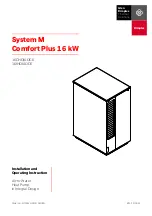
CRYO-U
®
Cryopump Instruction Manual
MA0D001E,2010.01
ULVAC CRYOGENICS INCORPORATED
D-1
Appendix D
PRINCIPLE OF CRYOPUMP OPERATION
Evacuation operation of the cryopump is accomplished by causing the gas molecule hit on a
surface (cryo surface) cooled to extremely low temperature to be condensed and absorbed on
the cryo surface.
Our CRYO-U® series cryopump uses a helium refrigerator for cooling the cryo surface and
clean high vacuum and extra-high vacuum can be obtained by simple operation.
The cryo surface is cooled to 12K to 20K according to the heat load.
When the cryo surface is cooled to 20K, the vapor pressure of nitrogen condensed on this
surface is less than 10
-8
Pa (refer to Fig.D-1). Therefore, gas (oxygen and argon, etc.) whose
vapor pressure is lower than that of nitrogen is normally condensed on the cryo surface and
evacuated.
Vapor pressure of neon, hydrogen and helium is 0.1Pa or more even at 12K, and the
CRYO-U® series cryopump cannot condense these gasses on the cryo surface. Such gasses
are absorbed and evacuated by the absorbent installed on the cryo surface.
Since the cryopump evacuates gas, as stated above, by condensing or absorbing the gas on
the cryo surface, evacuated gas is accumulated on the cryo surface. In the case of
condensation, when the quantity of the gas condensed on the cryo surface increases and the
condensed layer reaches certain thickness, surface temperature of the condensed layer rises
and the condensing speed of the gas molecules is lowered. In the case of absorption, when
the quantity of the absorbed gas approaches to the saturated absorbed quantity decided
according to the temperature of absorbent and the pressure of absorbed gas, absorbing speed
of the gas molecules is lowered considerably. Mainly due to these 2 factors, evacuation
performance (pumping speed and ultimate pressure) of the cryopump indicates remarkable
reduction from certain point with an increase in the quantity of the evacuated gas. Therefore,
it is necessary to set the temperature of the cryo surface to the room temperature
periodically, vaporize the condensed/absorbed gas components and exhaust them to the
outside. This operation is called “regeneration” by which the performance of the cryopump
can be recovered through the “temperature rise (exhaust of gas) -> degassing -> cooling”
process.
Summary of Contents for CRYO-U12H
Page 2: ......
Page 8: ...F 6 ULVAC CRYOGENICS INCORPORATED This page intentionally left blank...
Page 24: ...This page intentionally left blank S 12 ULVAC CRYOGENICS INCORPORATED...
Page 26: ...IW 2 ULVAC CRYOGENICS INCORPORATED This page intentionally left blank...
Page 46: ...Installation 4 10 ULVAC CRYOGENICS INCORPORATED This page intentionally left blank...
Page 60: ...Regeneration 6 8 ULVAC CRYOGENICS INCORPORATED This page intentioanlly left blank...
Page 64: ...Disconnection and Storage 7 4 ULVAC CRYOGENICS INCORPORATED This page intentionally left blank...
Page 78: ...Maintenance 8 14 ULVAC CRYOGENICS INCORPORATED This page intentionally left blank...
Page 86: ...Troubleshooting A 8 ULVAC CRYOGENICS INCORPORATED This page intentionally left blank...
Page 88: ...Flexible Hose B 2 ULVAC CRYOGENICS INCORPORATED This page intentionally left blank...
Page 100: ...CS 2 ULVAC CRYOGENICS INCORPORATED This page intentionally left blank...












































